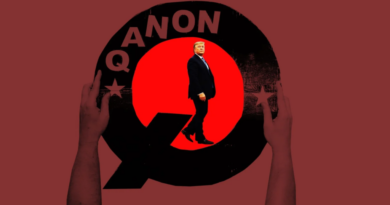Sound of Freedom: Why a film about human trafficking is accused of trafficking in QAnon conspiracies
If there’s a cause that seems fairly simple to rally behind, it would be efforts to combat human trafficking. It’s a crime involving the transportation and exploitation of people that is reported to police in Canada over 500 times a year and affects far more.
A new surprise blockbuster has drawn unprecedented — and deserved — attention to the problem. But the controversial film has come packaged with criticism of its star’s QAnon-adjacent views, and concerns about a glamourized portrayal of a nuanced problem that some worry leaves out the most likely victims.
Perhaps unsurprisingly, at a time when every spat opens a new front in the culture war, “Sound of Freedom” has deeply divided viewers. The first job of most movies is to entertain, but as a critic at Roger Ebert’s review site put it, this one is message first and story second. The tension stems from the way conspiracy theories are colliding with a very real cause, prompting the question of whether any attention is good attention.
“I look at this as both an opportunity but also something that is taking a lot of time and energy — and frustrating local movements,” says Kelly Tallon Franklin, the founder of Courage for Freedom in Ontario, which works to eradicate human trafficking.
The film is loosely based on Tim Ballard, the former American head of a group called Operation Underground Railroad, known for elaborate stings designed to trap child traffickers, and bills itself as “the gripping true story of a man’s mission to rescue children from the darkest corners of the world.”
It’s the biggest spotlight that human trafficking has gotten in years, but also showcases a Hollywood-ized version of trafficking — kids are taken by shadowy online forces and saved by one heroic man. Some advocates worry it obscures the real issues, and the real victims.
“One of the biggest issues that we’re facing as a national organization is the level of misunderstanding when it comes to human trafficking in Canada,” says Julia Drydyk, the executive director of the Canadian Centre to End Human Trafficking.
“Unfortunately, movies like “Taken” (the 2008 thriller in which Liam Neeson races to save his teenage daughter, kidnapped on vacation) even still have an impact, and have people looking for all of the wrong things when they think of human trafficking.
“In the Canadian context, I actually don’t see this as helpful at all.”
The film was third at the North American box office last weekend after it opened in Canada on July 7. For its second weekend, the film is playing on even more Canadian screens. A spokesperson for Cineplex, the country’s largest cinema chain, said that thanks to “strong audience demand” it would open more widely to accommodate more guests who want to see it on the big screen.
Here’s what you need to know.
Where did this movie come from?
“Sound of Freedom” took a winding road to theatres. It was shot five years ago, and initially bought by 21st Century Fox, before getting buried when that company was bought by Disney.
It was then acquired by a Utah-based company called Angel Studios, which declares its mission as creating stories that “amplify light.” It’s a phrase that many observers seem to have interpreted as meaning religious content, though company CEO Neil Harmon told the BBC he sees it as “values-based” content instead.
What’s clear is the company wants to give Hollywood a run for its money, and allows fans to pledge money to help decide which film the company should make or distribute.
The company also allowed people to go online and buy tickets for the film for other people, to help make it accessible to as many people as possible.
Isn’t raising awareness of human trafficking a good thing?
While the exploitation of people who have been trafficked is important, advocates worry that the movie risks giving viewers the wrong idea about how it works — meaning they won’t recognize the real thing if they see it.
When she watched it with a group of activists, the movie sparked a lot of conversation about trafficking that probably wouldn’t have happened otherwise, says Zeina Ismail-Allouche, an international child protection advocate based in Montreal.
“The movie is a great milestone in our journey,” she said, in terms of getting a general audience to pay attention. Working in child trafficking can be dangerous and challenging, though she takes issue with some of the ways it was portrayed — notably, the white saviour aspect.
Still, the challenge now, she says, is to take the groundswell of attention and turn it into a productive conversation about how to tackle trafficking in the real world.
“Inspiring a bunch of men and women that they’re going to take on vigilante roles? Put on their muscle shirt and go kick in a door somewhere? That can actually endanger victims and survivors,” as Franklin puts it. “Is that is that a doable process in Canada? No, no it’s not.”
The differences between what is shown in the film and what happens in real life are addressed on Angel’s website. For example, the movie opens with security camera footage showing kids being snatched from public spaces. “While such incidents do occur in the realm of human trafficking, it’s important to recognize that they do not represent the majority,” the website notes.
“When we think of “sex trafficking,” our minds often conjure up images of dimly lit foreign alleyways where vulnerable street children are abducted, exploited, and sold,” the website continues, before stressing that trafficking is an issue across the U.S., and “predators can take on various forms, including soccer coaches, trusted leaders, neighbours, uncles, and aunts.”
What do survivors think?
Franklin, herself a survivor of trafficking, says many are “furious,” not so much at the film, but at the fact that it takes a major movie to get people engaged.
There’s also frustration at the fact that the movie portrays the rescue as a man swooping into save victims, rather than acknowledging how hard many victims work to get themselves out of dangerous situations.
“If I would have been sitting there waiting for that, I’d still be entrenched in a lifestyle, and within communities where there was coercion, manipulation and exploitation.”
Why are people saying there are ties to conspiracy theories?
The star of the film, actor Jim Caviezel, best known for playing Jesus in Mel Gibson’s “Passion of the Christ,” has expressed opinions consistent with QAnon. The wide-ranging conspiracy belief is centred around the false idea that a group of Satanic elites run a child sex ring while controlling politics.
Despite a lack of evidence, it’s gained steam among the U.S. right wing in recent years and also made some inroads into Canada.
Caviezel has denied being aware of QAnon during filming and compared followers to persecuted Christians. Still, Caviezel has recently seemed to echo some false beliefs popular with the group. For example, he’s spoken about adrenochrome, a chemical compound that conspiracy theorists have claimed is extracted from kidnapped children by global elites. (There is no evidence to support this.)
Nevertheless, users of the Great Awakening, a primary message board for believers, have embraced the movie as their own.
The film’s release itself has also been dogged by conspiracies, with fans saying its release has been suppressed by a “woke” film industry.
Some have gone so far as to accuse theatres of making the film difficult to see — some American social media users have said, for example, that the theatres were too warm or too cold, or the film was even shut off entirely — prompting theatre chain AMC to come out and deny online rumours.
Why is QAnon so interested in this movie?
In recent years, QAnon has pushed conspiracy theories involving trafficking, including a 2021 claim that children were being held in furniture from an online store called Wayfair.
What should you know about human trafficking in Canada?
Human trafficking in Canada often looks a lot like intimate partner violence, Drydyk says. Often there is a strong psychological bond between the victim and trafficker, which can make dangerous situations tough to identify — especially when compared to cinematic scenes of kids getting snatched off the streets.
“Traffickers look for individuals with vulnerabilities in their lives. And this can be a really diverse set of experiences,” she says. Sometimes that means people who are struggling with homelessness, addiction or poverty.
“They tap into their greatest dreams and aspirations. They find out their greatest weaknesses, they love on them, but then they use that as a tool for psychological coercion and control to over time coerce them into the commercial sex industry.”
According to Statistics Canada, over 500 incidents are reported to police every year, but given how many trafficking cases are not reported, Drydyk says that’s just the tip of the iceberg.
Her organization believes there are thousands of people being trafficked in Canada every year, and it has recently seen an increase in labour trafficking.
JOIN THE CONVERSATION
This article has been archived for your research. The original version from Toronto Star can be found here.
:format(webp)/https://www.thestar.com/content/dam/thestar/news/canada/2023/07/16/sound-of-freedom-the-controversy-around-a-film-accused-of-distorting-human-trafficking-and-winking-at-qanon/_2car_sound_of_freedom.jpg)



